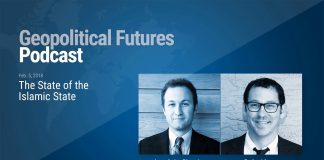Originally produced on Dec. 5, 2016 for Mauldin Economics, LLC
George Friedman
Wednesday will be the 75th anniversary of the attack on Pearl Harbor. It happened three-quarters of a century ago, but it remains the defining moment of our time. It continues to inform the way we look at the world, and it triggered a redefinition of the federal government that still haunts us in some ways.
That day—the way it happened and the manner in which we responded—redefined the United States… a redefinition that we still struggle with today.
The World Before the Attack
The origin of the attack was Japan’s extraordinary rise. When Commodore Matthew Perry forced Japan into trade relations with the United States in 1853, Japan was a society driven by animal and human muscles. There were no steam engines or railroads or any powered industry.
By 1905, the Japanese navy defeated the Russians, and Japan was rapidly emerging as a major industrial power. Japan’s great weakness was that it was devoid of mineral resources. It had to import almost all the resources an industrial society needed.
In order to sustain its industry, Japan had to deal with China, the Dutch East Indies, and Indochina. All three were under some degree of control by European powers. The Dutch East Indies (Indonesia) belonged to the Netherlands, Indochina belonged to France, and all major European powers plus the United States controlled much of coastal China. These were Japan’s economic competitors.
Over time, Japan became less and less economically secure, and in the 1930s, it invaded China. The US opposed the invasion as it did not want to face a Japanese challenge in the Pacific. It supported Chinese resistance against Japan.
The decisive moment came when Germany occupied France and the Netherlands in 1940. Japan had agreements with both countries about deliveries of minerals from their colonies. Now, the question became whether the colonial authorities would honor the agreements. The United States did everything it could to undermine the agreements. For example, President Franklin D. Roosevelt ordered his agents to buy up oil in today’s Indonesia to keep it out of Japanese hands.
Japan invaded Indochina to secure resources there. The US was a major exporter of oil and scrap iron to Japan, and it imposed an embargo. The Japanese had an oil reserve of a few months and no way to obtain more oil. The US demanded Japan withdraw from Indochina and China. Japan feared that if it agreed, the US would control Japan’s future.
Japan had to secure its control of Indochina and the Dutch East Indies. If it did that, US submarines operating out of the Philippines would still block the supply lines back to Japan. There was no way to occupy the areas it wanted without taking the Philippines, and that meant war with the United States.
The Americans anticipated a Japanese attack on the Philippines and planned to respond by sailing the US fleet out of Pearl Harbor. The US would force the Japanese navy into a decisive battle and destroy it, recapturing the Philippines.
Planning and Miscalculations
The Japanese knew of the American plan and knew that if the US chose the time and place of the engagement, they might lose. Therefore, Japan did what the US thought was impossible. It attacked Pearl Harbor from the north with aircraft carriers. The US fleet was crippled. It would be years before it could mount an attack against Japan. Meanwhile, Japan created a Pacific empire to block the inevitable US counterattack.
The Japanese assumed the US would negotiate a peace treaty. The US didn’t. The United States could not accept a challenger who might seek control of the Pacific. And in the long run, if the US accepted the cost of war, US industrial power would crush the Japanese. It did.
Note, the United States was using a strategy that has now become commonplace—the use of economic sanctions to try to compel another nation to change its behavior. It also revealed the problem with this strategy. First, the embargo might not be effective. Second, if there were an embargo, the target nation might choose war over capitulation. Thus, a strategy designed to avoid war through economic measures could result in war.
The United States expected a Japanese attack, but it didn’t anticipate that it would be at Pearl Harbor. An attack elsewhere could be reversed if the fleet at Pearl Harbor was intact. The miscalculation was threefold. First, the US did not think the Japanese would risk bringing their fleet within 300 miles of Hawaii in winter, from the freezing north through Pacific storms. Second, the US didn’t believe that carrier aircraft could sink battleships (in spite of a similar British attack on the Italian navy). Third, it believed that Pearl Harbor was too shallow for torpedo attacks. The US underestimated Japan’s daring, its naval air power, and its technological capabilities.
The US also suffered from complacency at all levels. Navy Lt. Kermit Tyler was on duty as watch officer the morning of Dec. 7. A radar operator informed him that aircraft were approaching from the north. In what has become a legend in the world of intelligence, he replied, “Don’t worry about it,” and didn’t sound the alarm.
Complacency and the underestimation of the enemy permeated all levels of US thinking. The US had pushed Japan into an untenable position and knew that it would strike, but never assumed that it would strike at the one place where the US didn’t want it to.
(Unforeseeable events can happen at any moment—that’s true not just for the world at large, but also for investing. So let me mention as a quick aside that my friends at Mauldin Economics have a great offer for those who want to protect and grow their assets in these turbulent times. See the bottom of this week’s issue for more details.)
The Legacies of Pearl Harbor
After the war, complacency was replaced by obsessive alertness. There is a place in Colorado Springs called NORAD (North American Aerospace Defense Command), where obsessive alertness became a religion. NORAD waited and watched 24/7 throughout the Cold War and continues to do so today… constantly aware of Kermit Tyler.
No scenario is too preposterous, no moment is totally secure, and any attack can come at any moment from any direction. This is not an irrational view. It is also one that changed the US permanently.
Pearl Harbor taught the United States that it could be destroyed by complacency. The US can be surprised (as it was on 9/11), but it constantly remains on the edge of its seat, never again as secure as it was on Dec. 6. This is one of the legacies of Pearl Harbor.
There was another, more transformative legacy. After Pearl Harbor, the United States had to build a vast military apparatus to face Germany and Japan simultaneously. To do this, the federal government had to virtually nationalize the economy. The flow of material, the allocation of personnel in factories, and the control of production of civilian goods were all decided by government planners. Civil liberties—from the rights of Japanese-American citizens to freedom of speech—were curtailed.
A religion of secrecy was imposed where vast areas of knowledge, mostly unimportant, were deemed vital to national security and controlled under a layered apparatus. The United States saw itself as fighting for its life, and few objected to the extension of the federal government’s power. But it changed American society to this day.
Reshaping the State’s Relationship to Its People
In many ways, the New Deal set the stage, but it really failed to achieve its end—the end of the Depression and the increase in federal power. It was World War II that did that, in ways that had been unthinkable before. The federal government changed its relation to society. It went from being a significant but distant part of life, to controlling even small details of ordinary life.
War was not a cover for this. There was a war, and the creation of a strong state to fight this war was inevitable and gave a sense of security. The state receded after the war but never went back to what it had been before. It remained an ever-present arbiter of daily life, and the nation never saw complacency as an option again.
War, to that point, had been part of American life, but now it became central. The US Army had been a few hundred thousand before the war… totally ineffective. That was never to happen again. US aircraft were not up to Japanese standards. That was never to happen again. Technology did not flow into the defense system from the private sector, but flowed outward. The Manhattan Project demonstrated what the state could create, and the microchip, the Internet, and computerized databases flowed out, to be turned into civilian products.
The national security apparatus remained at the center of American society, and the federal government, controlling that apparatus, gained overwhelming power. Perhaps most important, the pre-war illusion that war was marginal to our lives changed. The United States adopted a strategy of preemption or rapid response to any challenge—Korea, Vietnam, Iraq, Afghanistan, and Iraq again. And secrecy remained the veil over decisions that were made.
Some would object to this. They miss the point. Pearl Harbor happened. It is a dangerous world, and danger comes from unanticipated directions in ways that cannot be predicted. The United States did not create the world. The world created the United States, and it is what it is.
The simple act of dismantling the apparatus would not eliminate what we are afraid of. Denial of reality is not a strategy. And when 9/11 happened, everyone demanded to know how the president let it happen. Even with intense effort, the system will fail. But with no effort, the opportunities for disaster are endless.
Nevertheless, we must all be aware, 75 years later, of how the United States was permanently changed by a failure of imagination, a certainty of security, and an unwillingness to acknowledge how capable the enemy is. It resulted in a culture of anxiety, whether about Soviet nukes or Muslim terrorists. The tendency, back then, to minimize the Japanese has led us to maximize our fears now. It isn’t an irrational stance, but it is an exhausting one. The United States is in a reality that it cannot escape, but if it recognizes what happened, it can reshape or perhaps mitigate it.
Pearl Harbor isn’t ancient history. It is something that lives in the American psyche and is embedded in our national institutions. It is the lesson we never think of… but can never forget. And as we place embargos on our next adversary, it is important never to forget Pearl Harbor. If we remember, at least a young lieutenant might learn to be constantly anxious, even if it is a Sunday morning.










